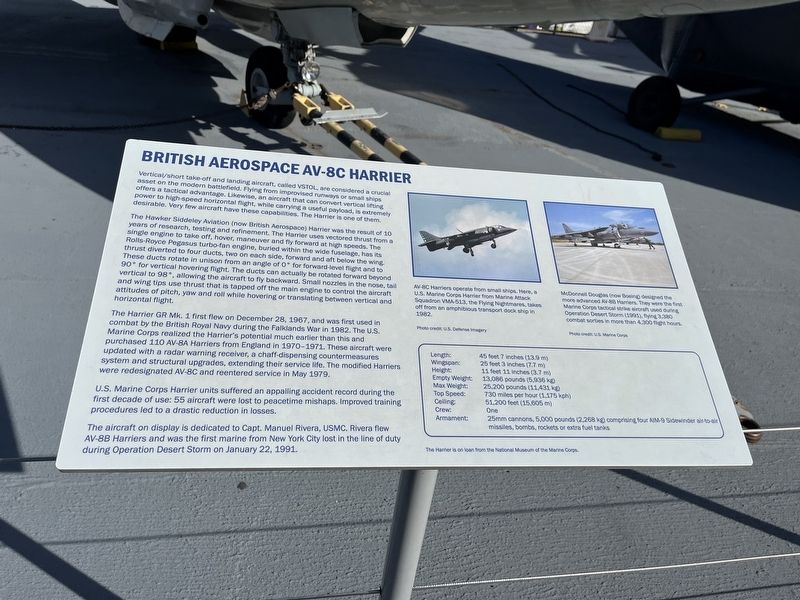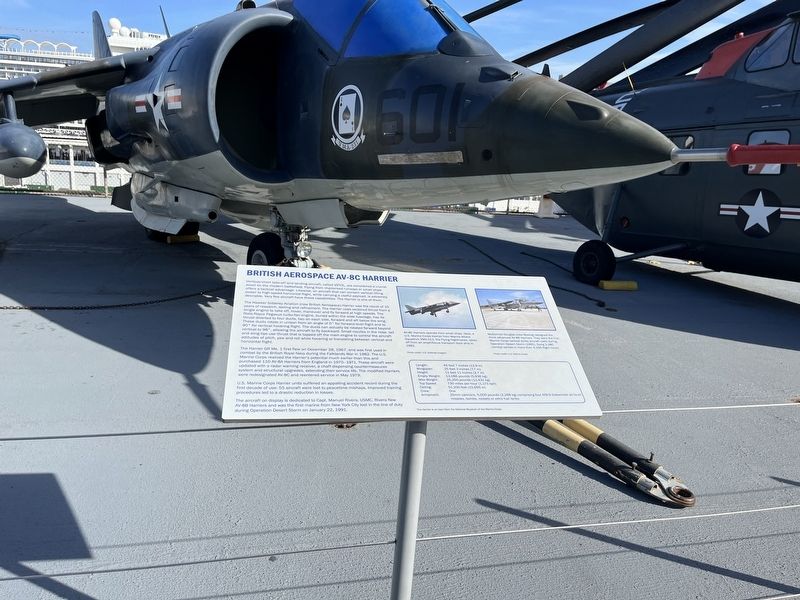Hell's Kitchen in Manhattan in New York County, New York — The American Northeast (Mid-Atlantic)
British Aerospace AV-8C Harrier

Photographed By Devry Becker Jones (CC0), November 5, 2022
1. British Aerospace AV-8C Harrier Marker
Vertical/short take-off and landing aircraft, called VSTOL, are considered a crucial asset on the modern battlefield. Flying from improvised runways or small ships offers a tactical advantage. Likewise, an aircraft that can convert vertical lifting power to high-speed horizontal flight, while carrying a useful payload, is extremely desirable. Very few aircraft have these capabilities. The Harrier is one of them.
The Hawker Siddeley Aviation (now British Aerospace) Harrier was the result of 10 years of research, testing and refinement. The Harrier used vectored thrust from a single engine to take off, hover, maneuver and fly forward at high speeds. the Rolls-Royce Pegasus turbo-fan engine, buried within the wide fuselage, has its thrust diverted to four ducts, two on each side, forward and aft below the wing. These ducts rotate in unison from an angle of 0° for forward-level flight and to 90° for vertical hovering flight. The ducts can actually be rotated forward beyond vertical to 98°, allowing the aircraft to fly backward. Small nozzles in the nose, tail and wing tips use thrust that is tapped off the main engine to control the aircraft attitudes of pitch, yaw and roll while hovering or translating between vertical and horizontal flight.
The Harrier GR Mk. 1 first flew on December 28, 1967, and was first used in combat by the British Royal Navy during the Falklands War in 1982. The U.S. Marine Corps realized the Harrier's potential much earlier than this and purchased 110 AV-8A Harriers from England in 1970-1971. These aircraft were updated with a radar warning receiver, a chaff-dispensing countermeasures system and structural upgrades, extending their service life. The modified Harriers were redesignated AV-8C and reentered service in May 1979.
U.S. Marine Corps Harrier unit suffered an appalling accident record during the first decade of use: 55 aircraft were lost to peacetime mishaps. Improved training procedures led to a drastic reduction in losses.
The aircraft on display is dedicated to Capt. Manuel Rivera, USMC. Rivera flew AV-8B Harriers and was the first marine from New York City lost in the line of duty during Operation Desert Storm on January 22, 1991.
Length: 45 feet 7 inches (13.9 m)
Wingspan: 25 feet 3 inches (7.7 m)
Height: 11 feet 11 inches (3.7 m)
Empty Weight: 13,086 pound (5,936 kg)
Max Weight: 25,200 pounds (11,431 kg)
Top Speed: 730 miles per hour (1,175 kph)
Ceiling: 51,200 feet (15,605 m)
Crew: One
Armament: 25mm cannons, 5,000 pounds (2,268 kg) comprising four AIM-9 Sidewinder air-to-air missiles, bombs, rocketsor extra fuel tanksPhotographed By Devry Becker Jones (CC0), November 5, 20222. British Aerospace AV-8C Harrier Marker
[Captions:]
AV-8C Harriers operate from small ships. Here, a U.S. Marine Corps Harrier from Marine Attack Squadron VMA-513, the Flying Nightmares, takes off from an amphibious transport dock ship in 1982.
McDonnell Douglas (now Boeing) designed the more advanced AV-8B Harriers. They were the first Marine Corps tactical strike aircraft used during Operation Desert Storm (1991), flying 3,380 combat sorties in more than 4,300 flight hours.
Erected by Intrepid Sea, Air & Space Museum.
Topics. This memorial is listed in these topic lists: Air & Space • Hispanic Americans • War, 1st Iraq & Desert Storm • War, Cold • Wars, Non-US. A significant historical date for this entry is January 22, 1991.
Location. 40° 45.88′ N, 74° 0.029′ W. Marker is in Manhattan, New York, in New York County. It is in Hell's Kitchen. Memorial can be reached from the intersection of 12th Avenue and West 46th Street, on the right when traveling south. Touch for map. Marker is at or near this postal address: 549 12th Ave, New York NY 10019, United States of America. Touch for directions.
Other nearby markers. At least 8 other markers are within walking distance of this marker. Douglas F4D Skyray (here, next to this marker); Skiorsky HRS (H-19) Chickasaw (a few steps from this marker); Douglas XBT2D-1 Dauntless II (AD-1 Skyraider) (a few steps from this marker); Beech T-34 Mentor (a few steps from this marker); Sikorsky HH-52 Seaguard (a few steps from this marker); Intrepid As Flagship (a few steps from this marker); Aermacchi MB-339 (a few steps from this marker); McDonnell F3H-2N (F-3B) Demon (a few steps from this marker). Touch for a list and map of all markers in Manhattan.
Credits. This page was last revised on January 31, 2023. It was originally submitted on November 8, 2022, by Devry Becker Jones of Washington, District of Columbia. This page has been viewed 94 times since then and 14 times this year. Photos: 1, 2. submitted on November 8, 2022, by Devry Becker Jones of Washington, District of Columbia.
